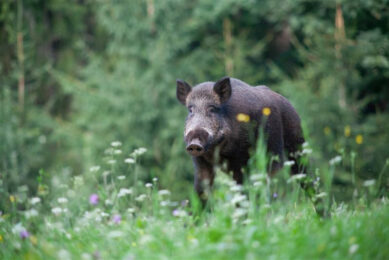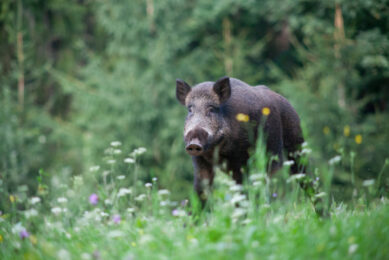In the months of September and October especially, this shows up mainly in lowered farrowing rate (-8 to 10%), reduced litter size (averaging in all sows, affected or not, 0.6 fewer pigs litter) and weaning to conception intervals well over seven days in many sows.
Not every year, however. Puzzlingly in my experience – the deficiencies occur spasmodically and at various degrees of severity from year to year and from farm to farm. What the textbooks don’t seem to cover – yet – are the financial implications. Some new marketing figures have drawn our attention to this aspect of the disorder.
The breeding penalties
The proportionate cost across the autumn and early winter period, when the breeding deficiencies occur, reduce the nominal value of a weaner by about 80% or €0.97 per pig. This figure is based on the records of my British clients over the past eight years and assuming that the nominal value of a weaner over the cost of producing it, can be taken at €4.83 per weaner (at 21 weaners per sow per year).
At first glance this doesn’t seem too bad, but some most interesting, detailed figures published recently by Colin Wooldridge of the (British) Meadow Quality Marketing Group puts a very different face to the problem and suggests that the real financial sting in the tail comes when the weaners reach slaughter weight.
The ‘knock-on effect’
The research Wooldridge describes, shows that the income from slaughter pigs due to the effect of summer and autumn infertility were very much reduced in Britain after years of above-average summer temperatures. The knock-on effect of fewer weaners born, especially across the autumn and early winter following a hot summer, has resulted in far fewer slaughter pigs being sent for processing 20 weeks or so later, especially in March-July, resulting in less pigmeat being available to the processors. The shortfall was aggravated by pigs being sent for slaughter at slightly lower weights as farmers attempted to meet their contracted numbers.
But how big was the shortfall? After the very hot British summer of 2003, Meadow Quality reported that there was a 77.5% increase in pig shortages compared to the annual average. Historically in the period 1973-1976, the figures for April-July were barely 4% and after 2005, 24.3%. The year 2006 was a near-record hot summer too, and we await the resultant ‘autumn infertility knock-on effect’ as I write. But the graph seems to be climbing.
Warning for the future?
If as the scientists predict we are to experience warmer summers all over Europe, then the term ‘seasonal shortfall’ will parallel ‘seasonal infertility’. Some parts of Southern Europe – substantial pork producers such as Spain – are expected to suffer increasingly hot summers so that some parts of Europe will be struggling to meet the demand for pork through March-August. If we in cooler Britain are experiencing this degree of shortfall then the European position looks – I’m tempted to say ‘ominous’ – but what will it do for prices (up?) and/ or consumption (down?).
Financial implications
The marketing group calculates that to compensate for finished pigs ‘lost’ due to seasonal infertility, in Britain during March-August for the years 2003-2005 averaged a €0.046 per kg or €3.47 per pig cost to the industry. If this can be viewed as a fairly typical cost to one European industry, then this is a lot more than the €0.97 per pig penalty I postulated earlier from the breeding deficiency aspect of seasonal infertility, which has been talked about up until now.
Yes, the sting in the tail is likely to appear long after autumn infertility has come and gone for the year in question.
All the more reason for you to re-read my last month’s article on how to combat the critical photoperiod (decreasing daylight) effect on autumn infertility. And to think hard about, and to invest in, keeping all breeding pigs cooler as global warming threatens.
Does stress matter?
The effect of stress on seasonal infertility has not been well researched. This is not too surprising as stress is difficult to measure accurately ( i.e. , scientifically) and therefore has to be assessed – usually rather subjectively, I admit – by people like myself and those veterinarians who work mainly on farms. We have already looked at how heat stress affects reproduction, especially in the boar. Working predominantly in an outdoor breeding part of Britain, as I do, I suspect – and it is only a suspicion – that sows kept in individual gestation crates elsewhere in Europe, even in countries whose summers are much warmer than here, may suffer less when the weather is really hot than sows kept in groups indoors or even those outside in fields. If true, a paradox for those confirmed welfare adherents?
One further observation. I’ve noticed that where the stockmanship is of the ‘crash/ bash/ smash’ type, usually on the larger farms, handling the pigs at or around breeding time can be at best perfunctory and hurried; at worst noisy, impatient and ‘care-less’. These farms seem to have more serious seasonal dips in reproductive performance and this is quite evident from the records I study.
I notice, too, that such farms also have more ‘second litter fallaway’ problems than those where the handling is more skilled, calmer and thus more restrained. Is this due directly to stress hormones interfering with the rebred first-litter sows’ breeding hormones, or is it due to a harmful effect on the pigs’ own immune system?
As I said, room for some research? Meanwhile it looks to me that stress does play a part in seasonal infertility. PP
Reference: Wooldridge, C., It costs our industry over a million pounds a month (UK), Pig World, March 2007, 26-27.












